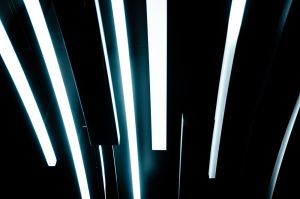As LED lighting is durable and energy efficient, they have become more and more popular when it comes to lighting up commercial spaces and buildings. In addition to saving on costs, it also comes with numerous health and environmental benefits. With that in mind, we dive deeper into what LED lighting is, the applications of LED lighting for commercial lighting installation, and the benefits that LED lighting brings to businesses. Keep reading below to learn more.

What is LED lighting?
LED stands for light emitting diode. These products tend to produce light up to 90% more efficiently than incandescent light bulbs. Diodes are usually made from a semi-conductive material such as selenium or silicon, which can conduct electricity in some situations and not in others. LED lighting components can usually be bought through retail stores, manufacturers, and suppliers – you can click on this link to check them out: https://hken.rs-online.com/web/c/displays-optoelectronics/led-lighting-components/
Applications of LED lighting
Warehouse lighting
Indoor storage facilities such as warehouses need a lot of light. This is because of their large surface area, but also the tall ceilings that are usually a feature of these buildings. As such, LED lights can be used to provide wider angle illumination so workers can see where they are going and where to place or pick up certain products.
Commercial office lighting
There are several types of LED lights that can be used for commercial office spaces, depending on the interior design aesthetics of the particular building. That said, most traditional office spaces are equipped with drop ceilings that use troffer fixtures that can be smoothly integrated into the panel grids. Other suspended LED fixtures are also popular for commercial building spaces, especially those that use open ceiling designs. These lights are usually stylish, and they provide a clean, sleek appearance for modern office buildings. If you’re considering a simpler and more efficient solution, you might be wondering: What are the best LED battens for offices? This type of lighting is becoming increasingly popular in offices for its energy efficiency, easy installation, and ability to deliver bright, even illumination across large areas.
Retail stores lighting
There are plenty of different fixtures that are used for retail stores, depending on the illumination requirements. For stores that have an open ceiling design, suspended linear ceiling lights tend to be a popular choice due to being very streamlined. With the right lighting automation and design, businesses can create more comfortable and inviting spaces that benefit both staff and customers.
Utility room lighting
As these rooms are not used on a constant basis when compared to other areas of a commercial building, simplicity and cost-effectiveness tend to be top priorities for businesses. Thanks to the low initial costs and ease of installation, LED lights remain a popular choice.
Conference room lighting
Conference rooms can use LED lights to provide the highest quality of illumination for conference room meetings. This can make the room reliable and provide an ideal atmosphere for a corporate office setting.
Benefits of LED lighting
No warmup time: While traditional bulbs can take up to 15 minutes to warm up to full power, LED lighting does not need to. Instead, workers can turn the lighting on and off whenever necessary, without worrying about any warmup time.
Capableoffrequentswitching: LED lights can be quickly turned on and off instantly without anydegradation to the light output or the device as well. This means device and energy lifespan is not compromised as they are not run unnecessarily when they are not needed.
Extended bulb lifespan: LED lighting tends to last longer than their traditional bulb counterparts. This means fewer replacements and less maintenance are needed, which reduces disruptions to employees by replacing bulbs.
Lower energy consumption: LED lighting tends to be a lot more sustainable than their traditional lighting counterparts, due to using 60% less energy to power up. This therefore helps businesses save a huge amount while also reducing their carbon footprint.
Greatercomfortandproductivity: LED lighting is the closest designers have come to natural lighting when it comes to illumination in an office workplace. Therefore, it provides similar benefits, such as boosting productivity and mood. It can also provide greater comfort when compared to traditional light bulbs. This means employees are less likely to complain about eyestrain, glare, headaches, and other common issues that may come with fluorescent light.
Powerfulilluminations: LED lights have the ability to shine brighter than standard light bulbs. This means perfect illumination and visibility, which is crucial to a worker’s productivity. Lighting can also ensure better safety for human workers, so they do not strain their eyes, trip over, or walk into things. Additionally, LED lighting remains durable, energy efficient, and has lower maintenance costs than their traditional counterparts.
Abilitytodimlighting: LEDs actually become more efficient when they run on less than full power. Moreover, the lifespan of a bulb increases when the device is run on less than full power. This means businesses can save money and costs by managing lighting in their commercial building in an intelligent way.
Bottom line
Overall, implementing LED lighting can be highly beneficial for businesses in various ways. They not only are more energy and cost-efficient, making them more sustainable to use, but they can also improve the overall mood and productivity of workers. Additionally, LED lighting can help to illuminate dark corners of a building, decreasing hazardous situations that a worker may encounter. As such, it is no surprise that more and more businesses are using LED components to light up their buildings.







